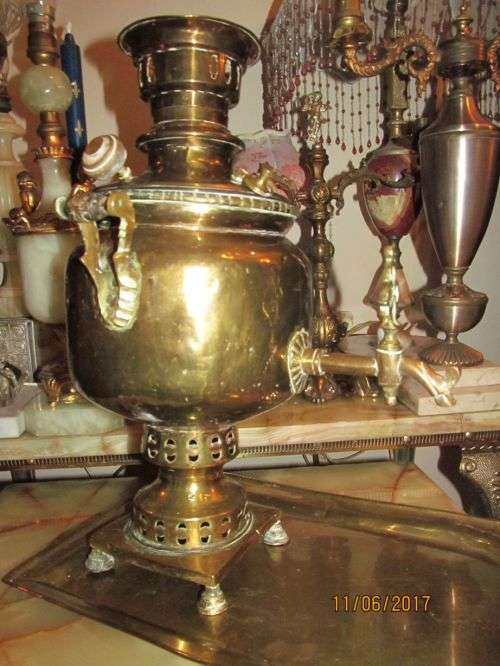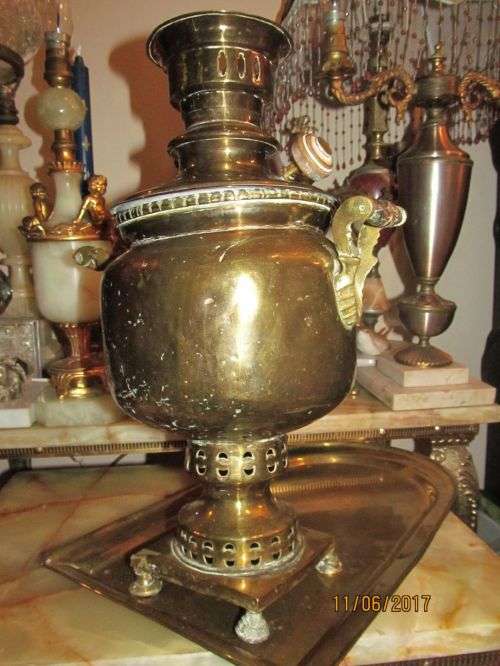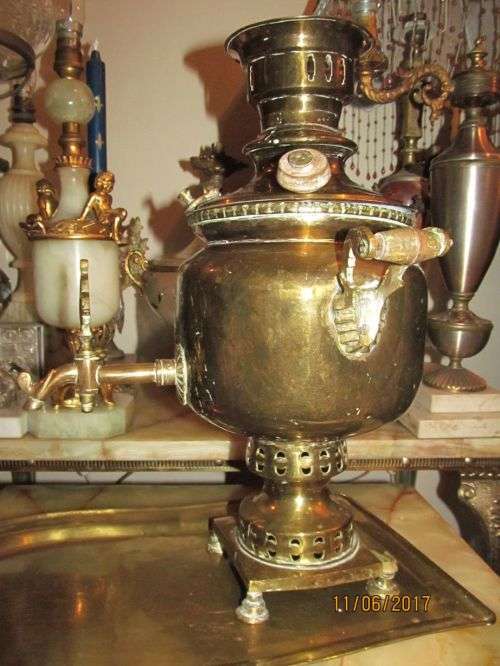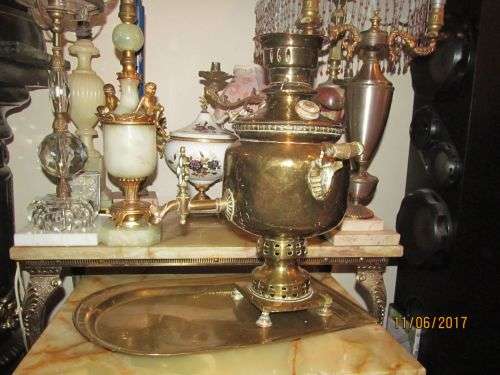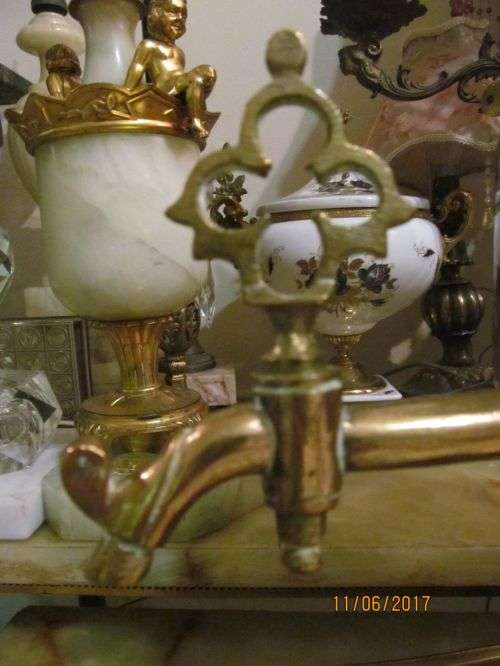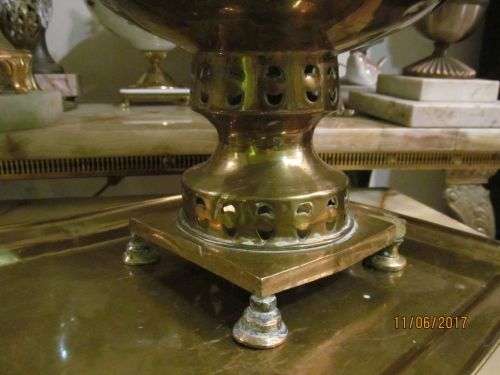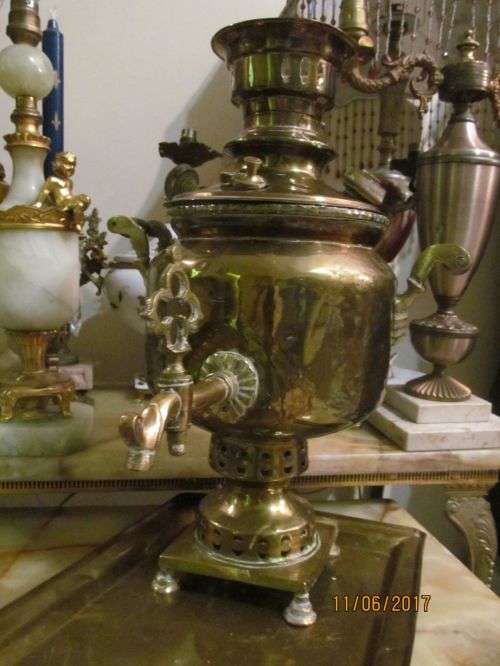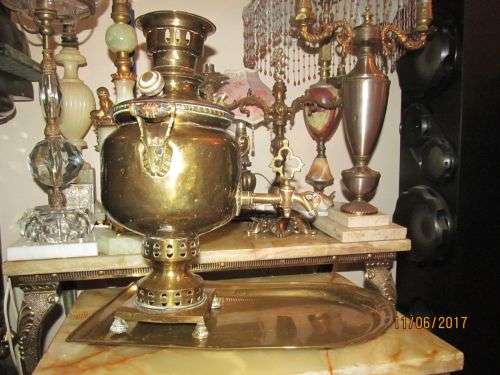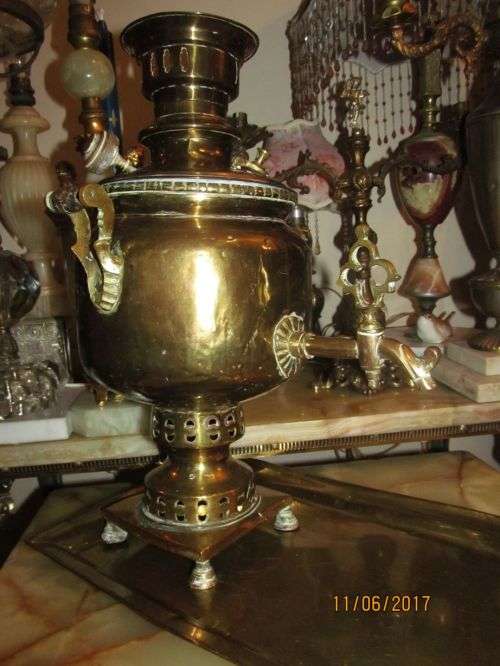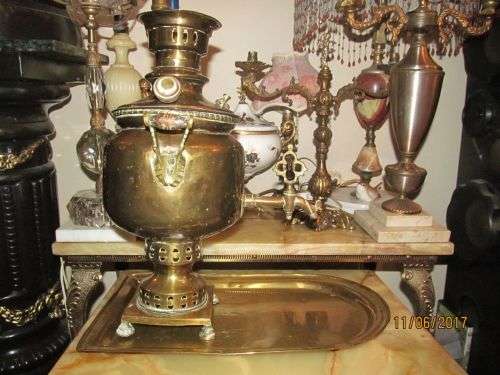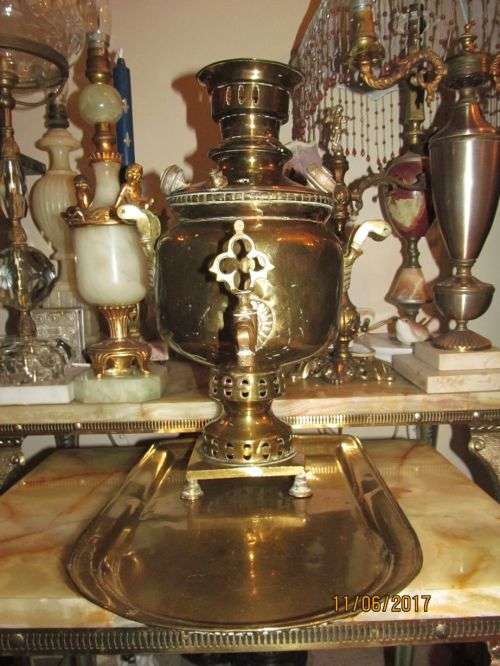
IMPERIAL RUSSIA !! Antique Authentic Russian Samovar with Original Tray - 18th Century
Check my rate
| Main centres: | 1-3 business days |
| Regional areas: | 3-4 business days |
| Remote areas: | 3-5 business days |

| Main centres: | 1-3 business days |
| Regional areas: | 3-4 business days |
| Remote areas: | 3-5 business days |
ANTIQUE 18th CENTURY AUTHENTIC RUSSIAN BRASS SAMOVAR WITH THE ORIGINAL TRAY
ALTHOUGH LISTED AS A "BUY NOW" ITEM ENABLING IMMEDIATE PURCHASE OF THIS RARE ITEM FOR THOSE WHO MAY WISH TO AVOID BIDDING AND/OR WAITING.....THIS ITEM WILL BE RELISTED ON MY REGULAR AUCTIONS AFTER A 2 WEEK PERIOD IN MY USUAL WAY (from 30th June)
A LARGE AND RARE DRUM SHAPED SAMOVAR OF YELLOW BRASS THE SAMOVAR SITS ATOP AN AMPLE SELF-FOOTED SQUARE BASE. IMPRESSIVE CRAFTSMANSHIP WITH A BEAUTIFUL DESIGN ELEMENT ON A CROSS SHAPED SPIGOT HANDLE/KEY AND A STYLIZED SPIGOT. THIS SAMOVAR HAS WOODEN HANDLES AND KNOBS FOR THE LID AND WAS MADE FOR COAL USE AS A FUEL - HOT COALS WERE PLACED INSIDE THE ROUND PIPE IN THE MIDDLE OF THE SAMOVAR AND WATER WAS POURED IN THE BOWL TO BE BOILED. A TEA POT IS TO BE PLACED ON THE TOP OF THE CROWN
ALL PARTS ARE ORIGINAL. WOODEN HANDLES AND KNOBS WERE NOT REPLACED AND GRAND CROWN FOR THE TEA POT IS OF FINEST PROPORTIONS . THE TRAY INCLUDED IS THE ORIGINAL SAMOVAR TRAY
THERE IS SOME REAL HISTORY BEHIND THE NOW WELL KNOWN " RUSSIAN SAMOVAR":
Its origin is connected with tea.
In the 18-th century in the Urals and Tula samovar-kitchens were invented, they were divided into three parts — in two of them the meals was cooked, in the third — tea. Sbitennik and samovar-kitchen were samovar prototypes.
Samovar manufacture appeared to be very profitable. Handicraftsmen quickly became manufacturers, workshops — samovar manufactures. In 1826 there were eight samovar factories, in 1896 — seventy. Samovars were made from cupronic-kel, red and green copper, brass, in some cases — from silver. Sometimes they were plated with gold, silver, but basic metal was always — brass. In the course of centuries samovar shapes changed. By the end of the 19-th century their quantity reached 165. It was almost impossible to mechanize samovars manufacture completely. Tools were also unchanged. By hand assembly five-six samovars per day were produced.
The highest peak of samovar manufacture in Tula is related to the 80s of the 19-th century. The Samovar was not only the feature of home comfort, the symbol of Russian hospitality, but also the sign of good circumstances.
STAMPS/MARKS ETC :THE ITEM IS NOT MARKED OR STAMPED - see REFERENCE BELOW:
Marks
Very few of the earliest samovars (mid-late 18th century) bear any markings to indicate where they were made.
In the 19th century, especially the second half, when samovar production became one of the dominant industries in the non-ferrous metal field, competing firms started marking samovars with their own trademarks, and decorating them with medals and emblems awarded to their workshop.
LINKS/EXAMPLES ETC : LINKS TO THE SIMILAR ITEMS:
http://www.russiansamovars.com/product_detail.php?ID=1010
http://www.ebay.com/itm/Antique-Vintage-BRASS-SAMOVAR-with-Lid-Tray-and-Tea-Pot-with-Lid-/272719284695
http://www.ebay.com/itm/Beautiful-Vintage-Antique-Traditional-Copper-and-Brass-Samovar-/222517229244
http://www.ebay.com/itm/Antique-Brass-Russian-Charcoal-Samovar-Samowar-w-Tray-Kolchugino-Factory-c-1920s-/172724462599
http://www.russiansamovars.com/russian-imperial-samovars.php
http://www.russianamericancompany.com/asam707-batashev/
CONDITION : THIS SAMOVAR LIVED A LONG LIFE AND WAS IN USE SINCE MANUFACTURE IT ALSO TRAVELLED A LOT. AND HAS A TRUE ANTIQUE LOOK- SOME SMALL DENTS WERE GRADUALLY ADDED TO THE QUALITY OF METAL WORK IN 18th CENTURY. THE HANDLES ARE INTACT. L
SIZE : SAMOVAR -- 38cm TOTAL HEIGHT TO CROWN..... 12cm by 12cm SIDES OF THE BASE.....20cm DIAMETER AT WIDEST PART.......27cm LENGTH FROM THE EDGE OF THE HANDLE TO THE EDGE OF THE HANDLE.......10.4cm DIAMETER OF THE CROWN.....10cm LENGTH OF SPOUT
TRAY -- 2cm HEIGHT.....37cm LENGTH.....23cm WIDTH
POSTAGE : COLLECTION PREFERRED DUE TO THE SIZE AND WEIGHT OF THE ITEMS .
POSTAGE METHOD IS BUYERS CHOICE (will be arranged upon request)

